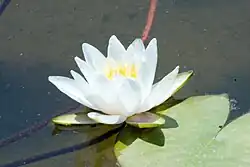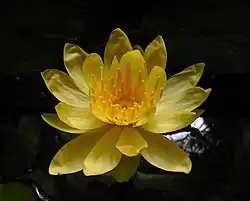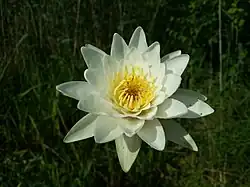Nymphaea × marliacea
| Nymphaea × marliacea | |
|---|---|

| |
| Nymphaea × marliacea 'Rosea' with a pink flower | |
| Scientific classification | |
| Kingdom: | Plantae |
| Clade: | Tracheophytes |
| Clade: | Angiosperms |
| Order: | Nymphaeales |
| Family: | Nymphaeaceae |
| Genus: | Nymphaea |
| Subgenus: | Nymphaea subg. Nymphaea |
| Species: | N. × marliacea
|
| Binomial name | |
| Nymphaea × marliacea | |
| Synonyms[1] | |
|
List
| |
Nymphaea × marliacea is an invasive[2] artificial waterlily hybrid of Nymphaea mexicana, Nymphaea alba[3][1] and or Nymphaea odorata.[4][5] It has been naturalised in Australia,[4] New Zealand,[6] North America,[7][3] and Europe.[5]
Description
_v3.jpg)
_27.jpg)

Nymphaea × marliacea
Lat.-Marl.


.jpg)
Vegetative characteristics
Nymphaea × marliacea is a perennial, aquatic,[4] rhizomatous,[8] herb[7][3] with large, branching,[9] stoloniferous,[8] horizontal, 35 mm wide rhizomes.[8] The glabrous,[10] suborbicular floating leaf[4] with a deep basal sinus[9] is up to 20 cm wide.[4] The leaves can extend beyond the water surface under crowded conditions.[11][12] The upper leaf surface shows a reddish brown marbled pattern, and the lower leaf surface displays purple spotting.[13] The glabrous petiole[10] reaches lengths of over 1 m.[9]
Generative characteristics
The large, often fragrant,[9] diurnal,[4] white,[11] or faintly pink or yellow,[14] up to 20 cm wide flowers float on the water surface[9] or extend beyond it.[15] The peduncle may reach lengths over 1 m.[9] The flower has four sepals.[4] The androecium consists of 50 stamens.[4] Flowering occurs from May to October.[13]
Reproduction
It is a (generally) sterile hybrid.[11][16][9] It can reproduce vegetatively through stolons.[8]
Taxonomy
It was described by Joseph Bory Latour-Marliac in 1888.[17][18] The taxon authority appears to be disputed. Some sources give Joseph Bory Latour-Marliac as the taxon author,[1][19][20] while others give William Wildsmith,[8][4][21] or William Watson as the taxon author.[22] However, W. Watson credited Joseph Bory Latour-Marliac with the name and its description,[17] and therefore the name should be assigned to Latour-Marliac.[22] Nymphaea × marliacea has not been typified.[22] It is placed in the subgenus Nymphaea subg. Nymphaea.[20]
Etymology
The hybrid name marliacea refers to the French horticulturist Joseph Bory Latour-Marliac (1830-1911).[22]
Hybridisation
A genetic analysis indicates it is closer to Nymphaea alba than to Nymphaea odorata.[23] A genetic analysis of ISSR data suggests that Nymphaea × marliacea, together with Nymphaea alba, forms a separate group from Nymphaea mexicana, Nymphaea odorata, and Nymphaea tetragona. The Nymphaea × marliacea-group is subdivided into two subgroups: Nymphaea × marliacea 'Chromatella' and Nymphaea × marliacea 'Albida' together with Nymphaea alba.[24]
Distribution
It has been introduced to Australia,[8][4] the United Kingdom,[19][22] Italy,[5][22] Spain,[22] Hungary,[22][25] Malta,[26] Canada,[7] the USA,[27][3] and New Zealand.[6]
Invasiveness
In Victoria, Australia it is regarded as somewhat invasive and it shows a slow dispersal rate.[28] Naturalised Nymphaea × marliacea plants grow vigorously and can cover almost the entire surface of ponds.[29][9] The naturalised plants appear to be planted deliberately and may not be able to disperse by themselves. Small populations may be eradicated through the removal of the rhizomes, but larger populations may require repeated mowing with specialised boats.[9]
Habitat
It has been found growing in ponds, lakes,[9][14] and canals.[14]
Ecology
It is a host plant to the phytopathogenic fungus Rhamphospora nymphaeae.[30]
Cultivation
It is one of the most commonly cultivated hybrids.[15] It is a cold-hardy plant with vigorous growth.[31] It grows well in 0.5–1.5 m deep ponds.[32]
References
- ^ a b c d Nymphaea × marliacea Lat.-Marl. (n.d.). Plants of the World Online. Retrieved June 3, 2025, from https://powo.science.kew.org/taxon/urn:lsid:ipni.org:names:605619-1
- ^ Bora, L. S., & Padial, A. A. (2023). A global review on invasive traits of macrophytes and their link to invasion success. Acta Limnologica Brasiliensia, 35, e20.
- ^ a b c d Natural Resources Conservation Service U.S. DEPARTMENT OF AGRICULTURE. (n.d.). Nymphaea ×marliacea Marliac [alba × mexicana]. USDA Plants Database. Retrieved June 3, 2025, from https://plants.sc.egov.usda.gov/plant-profile/NYMA2
- ^ a b c d e f g h i j A. Messina & P.G. Kodela. Nymphaea x marliacea, in P.G. Kodela (ed.), Flora of Australia. Australian Biological Resources Study, Department of Climate Change, Energy, the Environment and Water: Canberra. https://profiles.ala.org.au/opus/foa/profile/Nymphaea%20x%20marliacea [Date Accessed: 03 June 2025]
- ^ a b c Nymphaea ×marliacea Lat.-Marl. (n.d.). Portale Della Flora D’Italia - Portal to the Flora of Italy. Retrieved June 3, 2025, from https://dryades.units.it/floritaly/index.php?procedure=taxon_page&tipo=all&id=10279
- ^ a b Manaaki Whenua – Landcare Research. (n.d.). Nymphaea alba × mexicana. Biota of NZ. Retrieved June 4, 2025, from https://biotanz.landcareresearch.co.nz/scientific-names/8620ffca-d2dc-4515-92b7-f923b704fe0d
- ^ a b c Nymphaea ×marliacea Latour-Marliac. (n.d.). Database of Vascular Plants of Canada (VASCAN). Retrieved June 4, 2025, from https://data.canadensys.net/vascan/taxon/33343
- ^ a b c d e f Royal Botanic Gardens Victoria. (n.d.). Nymphaea ×marliacea W.Wildsm. VicFlora Flora of Victoria. Retrieved June 3, 2025, from https://vicflora.rbg.vic.gov.au/flora/taxon/00fe7238-8d13-4c23-adaf-545b1780469d
- ^ a b c d e f g h i j Nymphaea × marliacea Lat.-Marl. (n.d.). Biodiversità in Lombardia. Retrieved June 4, 2025, from https://www.biodiversita.lombardia.it/index.php?option=com_content&view=article&id=316:c04-nymphaea&catid=89:flora
- ^ a b Sagolsem, A. D., & Thongam, B. (2014). Two new taxa of Nymphaea (Nymphaeaceae) from Manipur, India. Phytotaxa, 188(2), 112-117.
- ^ a b c Conard, Henry S. (1905). The waterlilies: a monograph of the genus Nymphaea (pp. 221, 230). Pub. by the Carnegie Institution of Washington.
- ^ Mitra RL (1990) Nymphaeaceae. In: Nayar MP, Thothathri K, Sanjappa M (eds) Fascicles of flora of India, Fascicles 20. Botanical Survey of India, Kolkata, p. 24.
- ^ a b Neue allgemeine deutsche Garten- und Blumenzeitung. p. 231. (1888). Germany: R. Kittler.
- ^ a b c Coloured Water-lily - Nymphaea marliacea. (n.d.). NatureSpot. Retrieved June 4, 2025, from https://www.naturespot.org/species/coloured-water-lily
- ^ a b Schou, J. C., Moeslund, B., Weyer, K. v. d., Wiegleb, G., Lansdown, R. V., Holm, P., Baastrup-Spohr, L., Sand-Jensen, K. (2023). Aquatic Plants of Northern and Central Europe Including Britain and Ireland. p. 70. United States: Princeton University Press.
- ^ Nymphaea “Marliacea chromatella.” (n.d.). Missouri Botanical Garden. Retrieved June 4, 2025, from https://www.missouribotanicalgarden.org/PlantFinder/PlantFinderDetails.aspx?taxonid=261590&isprofile=1&gen=Nymphaea
- ^ a b Nymphaea marliacea Lat.-Marl. (n.d.). International Plant Names Index. Retrieved June 3, 2025, from https://www.ipni.org/n/605619-1
- ^ The Garden: an illustrated weekly journal of gardening in all its branches (Vol. 33, p. 292). (1871). https://www.biodiversitylibrary.org/page/25616364
- ^ a b Nymphaea marliacea Latour-Marl. (n.d.). NBN Atlas. Retrieved June 3, 2025, from https://species.nbnatlas.org/species/NBNSYS0000004978
- ^ a b USDA, Agricultural Research Service, National Plant Germplasm System. 2025. Germplasm Resources Information Network (GRIN Taxonomy). National Germplasm Resources Laboratory, Beltsville, Maryland. URL: https://npgsweb.ars-grin.gov/gringlobal/taxon/taxonomydetail?id=508109. Accessed 3 June 2025.
- ^ Nymphaea ×marliacea Wildsmith. (n.d.). GBIF | Global Biodiversity Information Facility. Retrieved June 3, 2025, from https://www.gbif.org/species/3697259
- ^ a b c d e f g h Dana, E. D., Verloove, F., Guillot Ortiz, D., Rodríguez-Marzal, J. L., Paredes-Carretero, F., Juan Bañón, J. L., ... & Garcia de Lomas, J. (2017). First record of Nymphaea× marliacea Lat.-Marl.‘Rosea’in the Iberian Peninsula: identification based on morphological features and molecular techniques. Bouteloua, 28, 132-139.
- ^ Reid, M. K., Sutton, G. F., Coetzee, J. A., Gettys, L. A., & Hill, M. P. (2024). Distribution and host preference of a potential biocontrol agent with a new association for the alien water lily Nymphaea mexicana in South Africa. African Journal of Aquatic Science, 49(2), 132-144.
- ^ Reid, M. K., Paterson, I. D., Coetzee, J. A., Gettys, L. A., & Hill, M. P. (2023). Know thy enemy: investigating genetic contributions from putative parents of invasive Nymphaea mexicana hybrids in South Africa as part of efforts to develop biological control. Biological Control, 184, 105291.
- ^ Balogh, L., Dancza, I., & Király, G. (2004). Actual list of neophytes in Hungary and their classification according to their success. Biological invasions in Hungary–Invasive plants, 61-92.
- ^ Mifsud, S. (n.d.). Nymphaea × marliacea (Marlia’s Waterlily). MaltaWildPlants.com - the Online Flora of the Maltese Islands. Retrieved June 4, 2025, from https://www.maltawildplants.com/NYMP/Nymphaea_marliacea.php
- ^ Water lilies. (n.d.). Missouri Department of Conservation. Retrieved June 4, 2025, from https://mdc.mo.gov/discover-nature/field-guide/water-lilies
- ^ White, M., Cheal, D., Carr, G. W., Adair, R., Blood, K. and Meagher, D. (2018). Advisory list of environmental weeds in Victoria. Arthur Rylah Institute for Environmental Research Technical Report Series No. 287. Department of Environment, Land, Water and Planning, Heidelberg, Victoria.
- ^ Brusa, G. (2015, July 30). Pistia stratiotes e Nymphaea x marliacea. Flora Insubrica. Retrieved June 4, 2025, from http://www.guidobrusa.info/2015/07/pistia-stratiotes-e-nymphaea-x-marliacea.html
- ^ The Plant Disease Reporter. p. 118. (1928). United States: Bureau of Plant Industry, U.S. Department of Agriculture.
- ^ Alderton, D. (2019). Encyclopedia of Aquarium and Pond Fish. p. 378. United Kingdom: Dorling Kindersley Limited.
- ^ Henkel, F., Rehnelt, F., Dittmann, L. (1907). Das Buch der Nymphaeaceen oder Seerosengewächse. p. 112. Germany: Henkel.